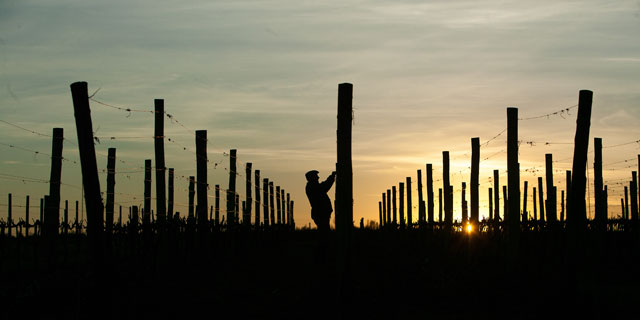Shhhh, Uruguay has a secret. Best known as a playground for the world’s yachting and martini class in Punta del Este, it has started getting notice on the world’s wine radar for their unique and delicious flagship wine, Tannat. But there’s more going on than just that powerful red; she’s blonde but exotic (of Spanish descent, you see), she wears floral dresses, and long after she’s languidly strolled passed, her perfume lingers, rich yet graceful. She is the lovechild of Viognier and Riesling. Meet Albariño.
South American Albariño
Most widely grown in its homeland the Rias Baixas in Galicia and neighboring Portugal (as vinho verde), Albariño is a wine that has somehow stayed out of the international spotlight. In South America, it was unheard of until recently. Enter Uruguay and its great climate for producing white wines with smashing acidity thanks to the cooling influence of their yacht-laden coast.
Eduardo Biodo, winemaker at the boutique winery, Bouza, near Montevideo, was a pioneer with the varietal in Uruguay. He humbly describes it as “an aromatic white, dry and with a notable acidity.” The main difference between the Spanish and the local version, he says, “seems to be due to increased sunshine exposure during maturity, this gives our Albariños a relatively higher percentage of alcohol, but maintains a good level of acidity.”
This higher alcohol, amongst other factors, plays a part in the complex and decidedly lush mouth feel of the wine. Bouza’s Albariño has become one of the most anticipated releases each year and shouldn’t be missed on any visit to Uruguay, well worth the substantial price tag it now carries.
[ pagebreak ]
Garzon’s vines are still young and add intensity to the fruit flavors of their white wines and the winery’s coastal location gives them the very best of the Uruguayan climate. All their whites, made by Bruzzone under the guidance of consultant Alberto Antonini, are lovely, but their Albariño reigns supreme.
A great pair with seafood, get down to the coast and try it with octopus or shrimp, and if you feel particularly decadent and have some cash to burn, head to Francis Mallmann’s El Garzon and open a bottle of Albariño alongside his famous grilled salmon. Be warned, you just might spontaneously stand and applaud.
Bottles to Try
Also keep an eye out on: Bodegas Carrau Juan Carrau Cepas Nobles Sauvignon Blanc, Bodega Garzón Sauvignon Blanc, and Gimenez Mendez Reserva Familiar Sauvignon Blanc.


![Making Mealtime Matter with La Familia: Easy Sofrito [Video]](https://thelatinkitchen.com/wp-content/uploads/2015/10/sofrito-shutterstock__0-500x383.jpg)
![Easy Latin Smoothies: Goji Berry Smoothie [Video]](https://thelatinkitchen.com/wp-content/uploads/2015/12/goji_berry-shutterstock_-500x383.jpg)
















![Fun and Fast Recipes: Fiesta Cabbage Salad [Video]](https://thelatinkitchen.com/wp-content/uploads/2015/11/fiesta_cabbage_slaw-shutterstock_-500x383.jpg)









